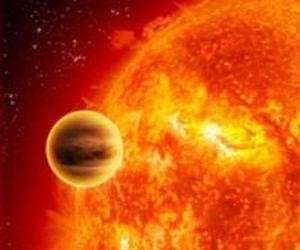An artist's image of a hot-Jupiter exoplanet. Astronomers have detected a new hot-Jupiter around a star very similar to the Sun, and measured its radius, mass, and density to better than about 10%. Credit: NASA
There are almost 1800 confirmed exoplanets known today, and over 4000 exoplanet candidates. Astronomers have obtained estimates for the masses and radii (and hence the average densities) of over four hundred of these confirmed exoplanets. The planetary density is critical: it provides astronomers with information about the average interior composition of the exoplanet and whether it is rocky like the Earth, largely gaseous like Jupiter, or something else. Although many different compositions can have the same average density, a large enough sample of exoplanets will enable statistical analyses to constrain planetary structure and formation models, and so scientists are working hard to increase the number of exoplanets in every category with reliable density measurements.
Nearly two hundred known exoplanets have masses larger than half a Jupiter-mass and orbit their host star in less than four days. They are in the class of hot-Jupiters, so-called because their proximity to their host star heats their atmospheres. Hot-Jupiters occur around 1% of all stars, at least in the solar neighborhood. Since only about 10% of exoplanets have orbits fortuitously aligned to allow a transit observation, astronomers need to monitor about 1000 stars to detect one hot-Jupiter by the transit technique.
CfA astronomers Lars Buchhhave, Allyson Bieryla, Dave Latham, Emilio Falcon, and Guillermo Torres and their collaborators have announced the discovery of HAT-P-55b, a transiting hot-Jupiter around a star that is very similar to the Sun; the star's mass and radius differ from the Sun's values by only a few percent. Using additional observations to follow-up the transit discovery, the scientists determined that the exoplanet itself has a mass of 0.582 Jupiter-masses, a radius of 1.182 Jupiter-radii, and an orbital period of 3.585 days – and obtained an overall precision in its density of better than 10%.
Only about 140 exoplanets have densities measured with this remarkable precision, and the new result significantly supplements the database for exoplanets, and hot-Jupiters in particular.
More information: HAT-P-55b: A Hot Jupiter Transiting a Sun-like Star. arxiv.org/abs/1506.03734
Provided by Harvard-Smithsonian Center for Astrophysics
























